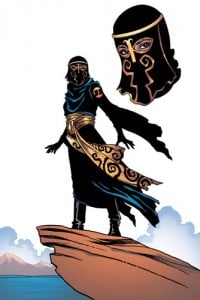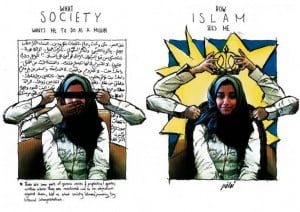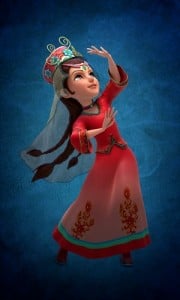Muslimah Media Watch thanks Safiya for the tip.
Asia Alfasi is a talented manga artist in the U.K. The BBC covered a talent competition she’d won (barikallah!), but managed to irritate me through mislabeling Ms. Alfasi’s drawings and misuse of the word “Arabian.”
Ms. Alfasi won a competition given by the International Manga and Anime Festival for her character “Monir,” who, according to the BBC, is a “feisty young Arabian from the Muslim Abyssinian times who draws strength from his faith to fight injustice and battle for his family’s survival.”
Does the BBC follow AP guidelines? Even if they don’t, I’d assume they’d know that an Arabian is a horse, not a person. Hmph!
Ms. Alfasi’s characters are beautifully drawn, but I’m tired of the “exotic” angle. She says, “I wanted to introduce some Arabian mysticism to the market.” A Muslim character from the Abyssinian times would be interesting enough, considering the fact that there is no such thing in Islamic history as the “Abyssinian Era” (unless they’re talking about when the Prophet and his followers went to Abyssinia…? Confusing!) Perhaps they meant Abbasid?
Anyway, a Muslim character from the Abbasid era would be interesting enough without exoticizing him. You could learn history and ancient culture…the nerd in me screams for more! What’s so mystical about him? What’s with the Aladdin outfit? Too close to Disney for comfort, personally.
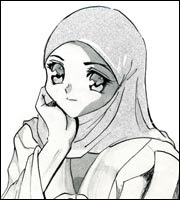 But I digress. Ms. Alfasi has drawn two characters that wear hejab, which are included in the story; one in a colored frame with Monir and one on her own. Yet neither of these characters has a name: the caption under the color comic says simply, “Monir” (as if he’s the only one in the frame), while the one underneath the hejabed character says, “Muslim character created by Asia.” I’m unsure whether this is the BBC’s fault or Ms. Alfasi’s. In newspapers, Muslim women are often depicted as swathed in fabric and nameless; must we be nameless in manga, too?
But I digress. Ms. Alfasi has drawn two characters that wear hejab, which are included in the story; one in a colored frame with Monir and one on her own. Yet neither of these characters has a name: the caption under the color comic says simply, “Monir” (as if he’s the only one in the frame), while the one underneath the hejabed character says, “Muslim character created by Asia.” I’m unsure whether this is the BBC’s fault or Ms. Alfasi’s. In newspapers, Muslim women are often depicted as swathed in fabric and nameless; must we be nameless in manga, too?
I’m inclined to believe this fault lies with the BBC after seeing the last black-and-white drawing of a young lady with that caption, “Monir.” I have a feeling that this young lady, with long hair, bangles, and earrings, is not a cross-dressing version of Monir. But perhaps it’s Monir’s alter ego, Monira? That’s a comic I’d love to see.
Ms. Alfasi has also created hijabstrip, which I found through the Muslim Manga website. This looks promising, but I can’t find any more on it. She’s also the author of JinNarration, and a book Native Narratives, that will be released in September about the adventures of a Muslim girl in both Libya and Scotland.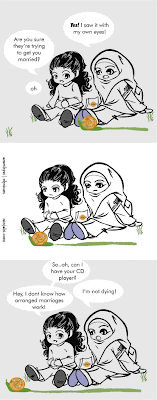
Through Muslim Girl magazine, I also found out about Ninjabi, a very cute manga-esque blog. It features several characters, the main of which is Noor, who is shown with and without hejab.
Finally! Realistic portrayals—through Ninjabi and hijabstrip—of Muslim women. I like Ninjabi’s drawings better because of the cleaner lines and the fact that they are more like comics, intending a joke rather than like manga that tells a story.
Ninjabi is refreshing. Noor is neurotic like teenage girls often are (cringing at memories of my teen years), her best friend is non-Muslim, and there is a Muslim character, Anny, who does not wear hejab. The best part of this: none of this is a big deal! Everybody just lives their cartoon lives. You can see more of Ninjabi here.
Because of manga’s prevalence and acceptance into mainstream American culture (I can’t really speak for other western cultures), I think Muslim comics’ entry into this medium is a great step. It’s silly to have to remind everyone that, “Hey, we’re just like you, we like manga, too,” but these comic strips, graphic novels, and websites do half that work for us. May these sisters (and others who aspire to similar work) find success, enshallah.



